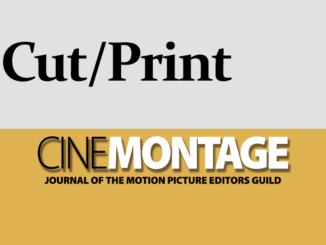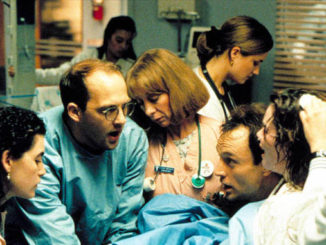
by Kevin Lewis • photos by Deverill Weekes
Editor’s Note: With the recent passing of award-winning editor Anne V. Coates, ACE, at the age 92 on May 8, we are re-posting this interview with her from the March-April 2010 issue of Editors Guild Magazine, the forerunner of CineMontage.
Few picture editors other than Anne V. Coates, A.C.E., have collaborated with such a wide variety of directors over a time span well surpassing half a century. With an editing career of 63 years––and still counting––Coates arguably has been working in cutting rooms longer than anyone else in film history, recently surpassing the impressive longevity of legendary editor Margaret Booth’s work history. And she’s not about to stop now; she’s currently considering two projects.
The secret of her success? Though she has no magic answer, a logical reason is Coates herself. She has a velvet-glove sensibility and a dry, British sense of humor, which reassures directors, producers and even actors. When Harrison Ford, the star and executive producer of her recent film Extraordinary Measures, successfully debated an editing decision, he hugged Anne to express his respect and thanks for her.
Last fall, the Academy of Motion Picture Arts and Sciences devoted an evening to Coates (see sidebar, Page 44). She won a well-deserved Academy Award for editing Lawrence of Arabia (1962), one of five total nominations over 35 years. She also was awarded the OBE (Officer of the British Empire) for her services to film. The British-born Coates, who lives in Los Angeles, has created a cottage industry of her own. All three of her children with her late husband, director Douglas Hickox, are successful directors and editors in the film industry.
While editing Extraordinary Measures in New York last summer, she took some time to discuss her career with CineMontage. >>>
CineMontage: You witnessed the transformation of the British film industry from quota quickies to a world-class cinema as the niece of J. Arthur Rank, founder of the Rank Organization and Rank Odeon cinema chain, which was a great source of national pride. But you aspired to be a racehorse trainer and a nurse before you took your place in the film industry. Why did you first work with a religious film studio instead of the Rank studio?
Anne Coates: J. Arthur Rank did not want me to go to the big studios. He thought I only wanted to get involved with films for the glamour, but I was really seriously interested in filmmaking. So he thought if he put me in religious films for a few months it would dampen my enthusiasm. It didn’t. I learned a whole lot there.
CM: Were you close to Reginald Mills, who was the editor for Michael Powell?
AC: He took over the first film I was working on as a second assistant, The End of the River. I learned a lot by watching him. He never told me anything. He hardly ever spoke to me! But later on, we became great friends. He was cutting The Red Shoes at that time so I was able to help with the dailies, splicing and things like that. I also spent quite a lot of time on the floor watching Mickey [Powell] direct.
CM: You worked with several distinguished British directors, including Carol Reed, Ronald Neame and David Lean, who was a former editor. Were you close to Lean because he was a noted editor?
AC: I suppose it was partly because he was an editor. David and I got on very well together. He liked me because I thought like him.
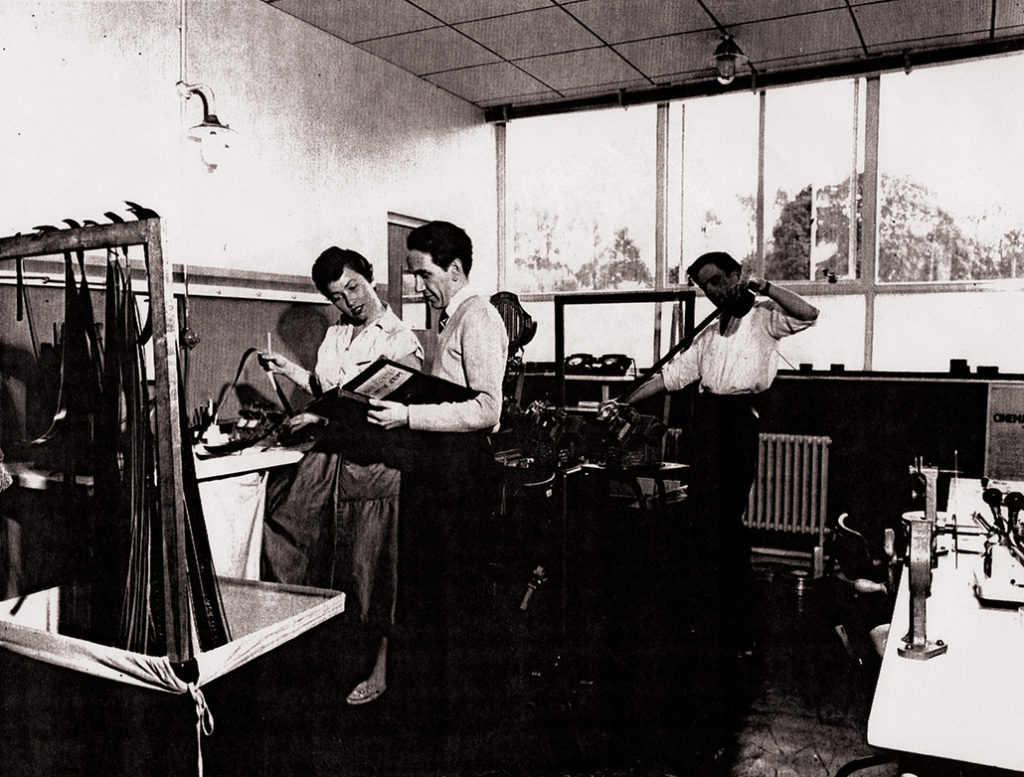
CM: Both of you had a great sense of painting and balance in art. The scenes in a Lean film are like a moving canvas that takes in all the elements. In the films you edited, there is a great sense of composition and rhythm. The landscapes of Lawrence of Arabia have a dramatic personality as well as pictorial meaning beyond mise en scène. How did you develop that timing––holding a shot and not cutting away for the actor?
AC: I don’t think you learn it. I think you just fall into it. I never went to any kind of film school. If you believe in it, you should do it. They cut down everything so short these days and don’t let it play out to its proper length.
CM: How would you describe your working relationship with Lean?
AC: It wasn’t until we got to Spain, after we had been shooting for eight months, that he was able to see dailies. So I used to go down to Spain once a month with the dailies and run them with him. And he would talk to me about the scenes, so I had an idea what was in his head. Then I would come back to England and cut it. But he wouldn’t see a scene until I had actually cut it. Luckily, I had the same rhythms and feelings about things and, generally speaking, we were on the same wavelength. When he came back to England, we ran them together and made alterations and changed takes.
CM: Did he make a lot of changes?
AC: He did quite a lot to some scenes and not very much to others. I had far too much desert because it was so fantastic, particularly the mirage stuff. We had to cut quite a lot of that out. David’s very brave about cutting. I’d say, “No, we can’t lose that; it’s fantastic.” And he’d say, “We can’t have all that; some of it has to go.”
Even now I’m like that. I’m not a cutter who goes ripping into films. I like to stop and think about what I’m doing before I cut. You have to make films so short these days. I think each film has a length it should be. A few minutes here and there can make a film a lot better––even though it’s considered too long.
CM: You worked with him on the restoration of the film in the late ‘80s. What was that like?
AC: An interesting thing happened on Lawrence when we were doing the 1989 restoration. Because we had to finish the original cut so quickly––16 weeks!––I said to David, “You know, we often didn’t have the time we would have liked to cut some of the scenes, so why don’t I cut them down now?” He wasn’t so sure about that, but he said, “Take a couple of the scenes away and cut them shorter, the way we would have done them if we had more time.” So I did that, and when we ran them, we just looked at each other; they didn’t work. The scenes only worked at the length we had first cut them because they had their own kind of life and rhythm. So we put them back as they were.
CM: The two films you edited for Ronald Neame––The Horse’s Mouth and Tunes of Glory––are classics. Tunes of Glory is a fairly theatrical film with some wonderful scenes between Alec Guinness and John Mills.
AC: I loved working with Ronnie. Yes, it was very exciting cutting those dialogue sequences. I try to cut every film I do with a fresh eye; I don’t go with a pattern or anything. I just read it, assimilate it and cut it. Films are all different. Sometimes I have some ideas of what I’m going to do. But when I actually come to do it, I will change that around. I won’t be bound by the way I want to cut it. I go more by the performances.
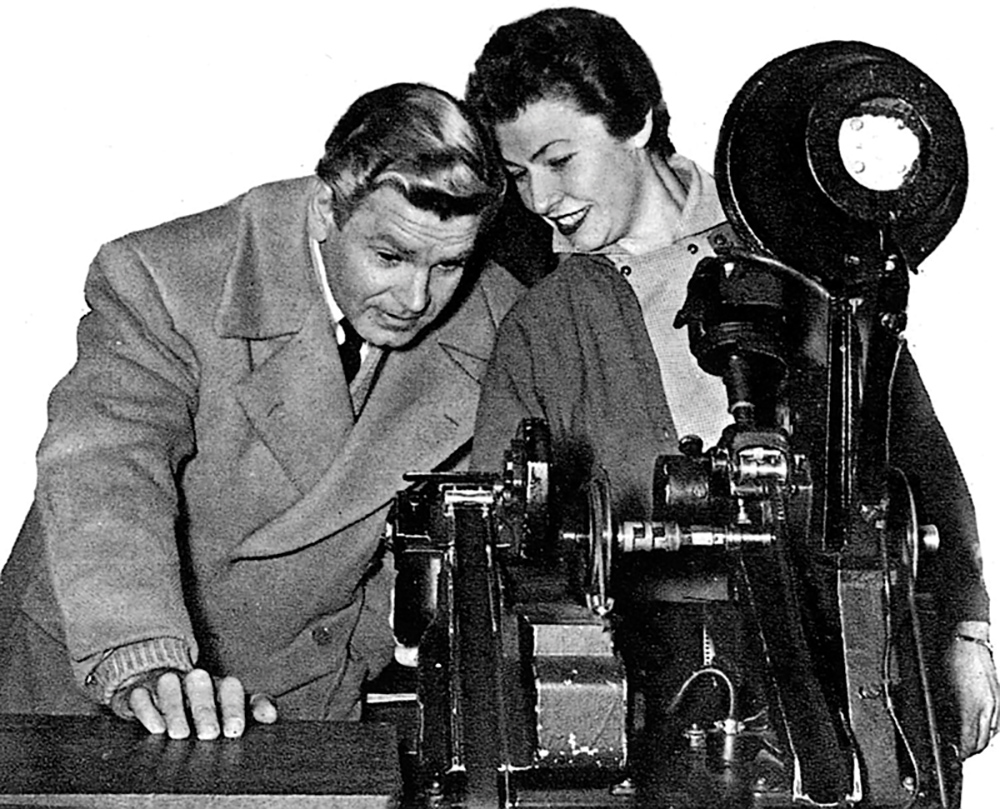
Courtesy of the Ronald Grant Archive
CM: Young Cassidy was begun by John Ford and completed by Jack Cardiff.
AC: Ford interviewed me and said, “If she’s good enough for David Lean, she’s good enough for me.” I never got to know him because I was in England, and he was shooting in Ireland. He never wanted to see any cut material. He told me that at the beginning. He said he never saw his cut stuff. He would leave it up to me because when he shot it, he knew how it was going to look. I was very disappointed when he went off the film. He had cataracts and had to go into hospital. I liked Jack Cardiff a lot, and knew him already from The Red Shoes, which he shot.
CM: You and Steven Soderbergh had a good working relationship on Erin Brockovich and Out of Sight, and you welcomed the challenges involved in working with an often-nonlinear director. Did you have lengthy discussions about the way he wanted the films to be cut?
AC: He doesn’t work that way. He doesn’t talk to you a lot about the film beforehand, which I like. I mean, you can’t really compare Out of Sight and Erin Brockovich. They are very different, and his whole approach to them was different. On Out of Sight, he worked side-by-side with me a lot, and on Erin Brockovich he kind of left it to me. He didn’t come into the cutting room. He does a lot of flash cutting. He does a lot of nonlinear cutting, which is quite fun to do, and he kind of challenges you. We didn’t use all the unusual cuts we tried in Out of Sight because it would have been too overbearing.
CM: Do you enjoy nonlinear narrative?
AC: Yes. There are nonlinear small things in my editing sometimes that you might not even have noticed. I started jump-cutting from one place to another quite a lot. When I was editing Becket, the producer, Hal Wallis, said, “You can’t do that. You can’t cut from this shot to that shot without a dissolve as they are 50 miles apart.” I said, “Guess what? I’ve done it and it works perfectly.” And it’s still in the film.
CM: What made you change from film to digital editing?
AC: Circumstances, really. I didn’t think I’d have to change so quickly but digital caught on really fast. I thought just the young editors would do it, but people my age were going to it too, so I realize I would just have to.
When Frank Marshall and Kathleen Kennedy offered me Congo, they said, “Well, you have to do it digitally because the special effects system couldn’t do it otherwise.” So they had me taught on Lightworks. It was quite a complicated film because there were three units shooting. I had my film crew taught how to work digitally because none of them had ever done that before. I wanted people who thought like film, not people who thought like computers.
It’s just another tool, really. Once I got that in my mind, I progressed faster. And then, when I did Out of Sight, Steven Soderbergh had a sound man who could link up with an Avid [Media Composer] but not with a Lightworks. I moved then from Lightworks to Avid, and I’ve stayed on an Avid ever since.
CM: What is the ideal relationship between a director and an editor?
AC: You both should see the film in the same way. I don’t think an editor should come on and try to make the film much different from the way the director sees it. You may have to do a little re-shooting to save the film, but mostly you should enhance what the director wants to tell.
Hopefully, you are on the same wavelength with him or her. Generally speaking, you should both like the same kind of performances.
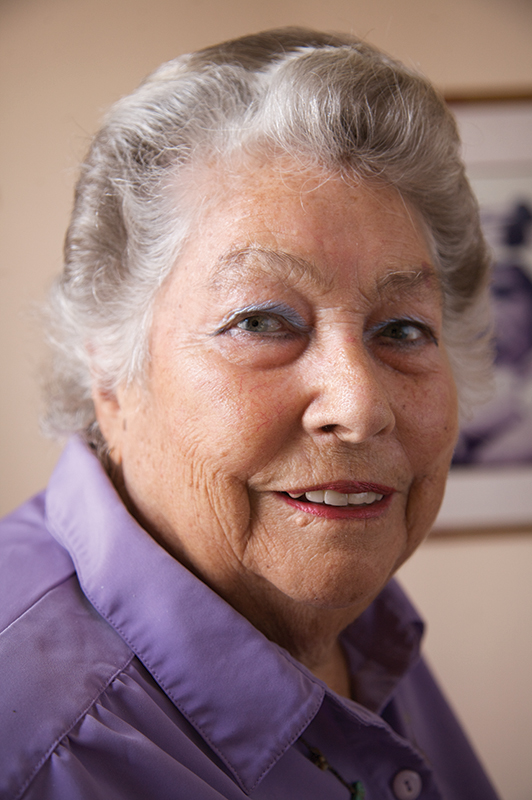
CM: What would you say is your editing style?
AC: I feel that I don’t have a style of editing. I didn’t think I did, but my daughter, who was studying theatre at university, asked me, “What’s your style, mum?” And I said, “Oh, Emma, I don’t have a style,” and she said, “Oh, yes you do––we’re studying it in class.” So, whatever my style was, they discussed it––but I never discussed it. I was so surprised that I had one.
CM: Your whole family is involved with the film industry.
AC: My late husband, Douglas Hickox, was quite a successful director. My oldest son, Anthony Hickox, wanted to be an actor, but when he spent time on the floor he realized that the director was in charge. He has now directed more than 20 films. My daughter is a successful editor based in London; Emma Hickox, A.C.E. My son James Hickox is a director, writer and former editor.
CM: Did you ever want to be a director?
AC: Yes, when I was younger. But as soon as I had children, I realized I would have to give up too much of my life to directing, and would not be able to give enough to my children. Whereas, as an editor, you can do both fairly successfully. The director has to be there; if he’s not there at 7:30 in the morning, the show doesn’t go. If the editor comes in late because a child has a cough, no one really knows as long as you keep up with the day’s cutting. My husband was a director––and one in the family was enough. I produced one film, The Medusa Touch, but I didn’t like producing because it was not hands-on enough.
CM: Which of your films gave you the most satisfaction?
AC: I suppose films like The Elephant Man. When I first read the script, I thought, “No way can I look at that face on my Moviola!” When I got to the end of the script, I was in tears and said, I have to do this film. I think that gave me a lot of satisfaction. Working with David Lynch was very interesting. I always say, “I have worked from David Lean to David Lynch––and all those directors in between.”


